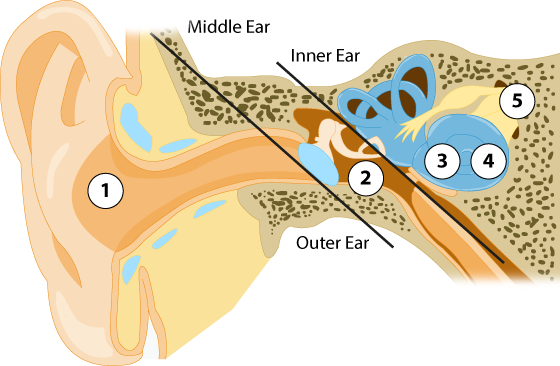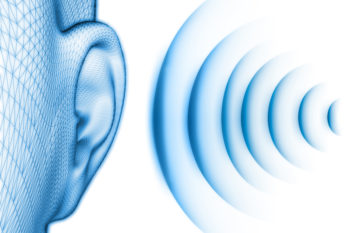Types of Hearing Loss
Get expert help selecting the proper hearing solution
Different Types Of Hearing Loss
Hearing loss can be experienced in varying degrees, such as mild, moderate, moderately-severe, severe or profound. Additionally, this loss can also vary depending on pitches or frequencies. A series of hearing tests can determine the amount of loss you experience compared to an average of many other adult listeners with typical hearing.
The volume of sounds you hear is measured in decibels (dB), 15-20 dB being the softest whisper and 120 dB being a jet engine. The softest sounds one can hear are called thresholds. Normal hearing thresholds for adults are considered 0-25 dB across the range of frequencies tested. Speech testing is also conducted as a part of this series of evaluations and helps to assess the levels of particular words you can hear clearly. These tests can help determine the type of hearing loss you’re experiencing, which can be categorized conductive, sensorineural or mixed.
Conductive Hearing Loss
Conductive hearing loss occurs when there is a problem with the way sound is conducted to the inner ear and a structure called the cochlea. The problem may lie in the ear canal, eardrum (tympanic membrane) or the middle ear (ossicles and Eustachian tube). The inner ear and auditory nerve remain unaffected in this type of hearing loss.
Symptoms for conductive hearing loss are similar to the other types; however, individuals may complain of sounds being muffled or far too quiet.
Some causes of conductive hearing loss can include:
- Outer or middle ear infections
- Complete earwax blockage
- Deterioration of the middle ear bones (ossicles)
- Otosclerosis, the fixation of the ossicles
- Perforated tympanic membrane or a hole in the eardrum
- Absence of the outer ear or middle ear structures
Conductive hearing loss may be temporary or permanent, depending on the source of the problem. Medical management can correct some cases of conductive hearing loss, while hearing instruments may be a recommended treatment option in long-standing or permanent cases.
Sensorineural Hearing Loss
Sensorineural hearing loss occurs when there is a problem with the sensory receptors of the hearing system, specifically in the cochlea of the inner ear or auditory nerve. The majority of sensorineural hearing loss occurs as a result of an abnormality or damage to the hair cells in the cochlea. This abnormality prevents sound from being transmitted to the brain normally, which results in a hearing loss.
Individuals with sensorineural hearing loss may hear muffled speech, suffer from tinnitus (or ringing in the ears), have difficulty hearing in background noise or clarity of speech problems.
There are a number of causes of sensorineural hearing loss, including:
- Congenital: These hair cells have been abnormal since birth, which is considered a congenital condition.
- Damage to hair cells: A deficit in hearing also occurs when the cells are damaged as a result of genetics, infection, drugs, trauma or over-exposure to noise (late-onset or acquired).
- Presbycusis: Age-related hearing loss
Sensorineural hearing losses are generally permanent and may remain stable or worsen over time. Routine hearing tests are needed to monitor the hearing loss. Hearing aids are the most common and successful treatment, allowing hearing professionals to adjust settings as needs change.
Mixed Hearing Loss
Mixed hearing loss occurs when a person has a sensorineural hearing loss in combination with a conductive hearing loss. This means there is a problem in the inner ear as well as in the outer and/or middle ear.
The conductive hearing loss may be temporary or permanent, depending on the source of the problem. Mixed hearing loss can sometimes be treated with medical management and hearing aids are a common treatment recommendation.
Normal Ear Functions
Hearing is an important sense to your everyday life. From alarms to important conversations throughout the day, our sense of hearing is important to communicating information. The way the auditory system works is incredibly complex and requires a number of functions to work properly, including:
- Sound is transmitted through the air as sound waves from the environment. The sound waves are gathered by the outer ear and sent down the ear canal to the eardrum.
- The sound waves cause the eardrum to vibrate, which sets the three tiny bones in the middle ear into motion.
- The motion of the three bones causes the fluid in the inner ear, or cochlea, to move.
- The movement of the fluid in the inner ear causes the hair cells in the cochlea to bend. The hair cells change the movement into electrical impulses.
- These electrical impulses are transmitted to the hearing (auditory) nerve and up to the brain, where they are interpreted as sound.
The Outer Ear
The visible part of the outer ear is called the pinna, or auricle. The pinna, with its grooves and ridges, along with the ear canal provide a natural volume boost for sounds in the 2000-3000 Hz frequency range, where we perceive many consonant sounds of speech.
The ear canal, also called the external auditory meatus, is the other important component of the outer ear. The ear canal is lined with only a few layers of skin and fine hair, and is a highly vascularized area. This means that there is an abundant flow of blood to the ear canal. Wax (cerumen) accumulates in the ear canal and serves as a protective barrier to the skin from bacteria and moisture. Earwax is normal and varies in amount based on the person. It only becomes problematic if it completely blocks the ear canal.
The Middle Ear
The eardrum, or tympanic membrane (TM), is the dividing structure between the outer and middle ear. Although it is an extremely thin membrane, the eardrum is made up of three layers to increase its strength.
The ossicles are the three tiny bones of the middle ear located directly behind the tympanic membrane. These three bones form a connected chain in the middle ear. The ossicles take mechanical vibrations received at the tympanic membrane, increase the strength of these vibrations and transmit them into the inner ear.
The Eustachian tube is the middle ear’s air pressure equalizing system. The middle ear is encased in bone and does not associate with outside air except through the Eustachian tube. This tubular structure is normally closed, but it can be involuntarily opened by swallowing, yawning or chewing. It can also be intentionally opened to equalize pressure in the ears, like when flying in an airplane. When this happens, you might hear a soft popping sound.
The Inner Ear
The inner ear is an organ located deep within the temporal bone, which is the bone of the skull on both sides of the head above and to the sides of the outer ear. The inner ear has two main structures: the semicircular canals and the cochlea.
The semicircular canals do not contribute to hearing, but assist in maintaining balance as we move. The cochlea is the hearing organ of the inner ear, which is a fluid-filled structure that looks like a snail. The cochlea changes the mechanical vibrations from the tympanic membrane and the ossicles into a sequence of electrical impulses. Sensory cells, called hair cells, bend in the cochlea as the fluid is disrupted by the mechanical vibrations. This bending of the hair cells causes electrical signals to be sent to the brain by way of the auditory nerve. The cochlea is arranged by frequency, much like a piano, and encodes sounds from 20Hz (low pitch) to 20,000Hz (high pitch) in humans.

Contact Us Today
Flexible appointments – 410-288-7100
I didn’t realize I wasn’t hearing the sound of my own voice. I am so humbled by the kindness and empathy shown to me

Jennifer Adams
Patient
Better hearing is here for you
Learn more about hearing loss and how it impacts the quality of your life.
